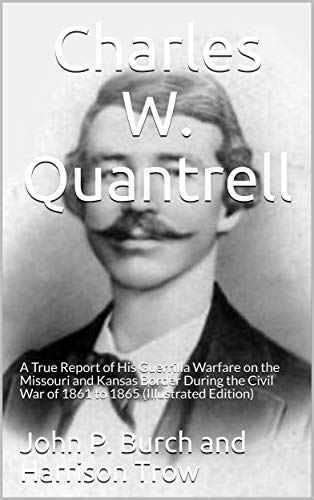Charles W. Quantrell: A True Report of his Guerrilla Warfare on the Missouri and Kansas Border During the Civil Was of 1861 to 1865
Harrison Trow
eBook
(Library Of Alexandria, March 16, 2020)
The early life of Quantrell was obscure and uneventful. He was born near Hagerstown, Maryland, July 20, 1836, and was reared there until he was sixteen years of age. He remained always an obedient and affectionate son. His mother had been left a widow when he was only a few years old. For some time preceding 1857, Quantrell’s only brother lived in Kansas. He wrote to his younger brother, Charles, to come there, and after his arrival they decided on a trip to California. About the middle of the summer of 1857 the two started for California with a freight outfit. Upon reaching Little Cottonwood River, Kansas, they decided to camp for the night. This they did. All was going well. After supper twenty-one outlaws, or Redlegs, belonging to Jim Lane at Lawrence, Kansas, rode up and killed the elder brother, wounded Charles, and took everything in sight, money, and even the “nigger” who went with them to do the cooking. They thought more of the d——d “nigger” than they did of all the rest of the loot. They left poor Charles there to die and be eaten later by wolves or some other wild animal that might come that way. Poor Charles lay there for three days before anyone happened by, guarding his dead brother, suffering near death from his wounds. After three days an old Shawnee Indian named Spye Buck came along, buried the elder brother and took Charles to his home and nursed him back to life and strength. After six months to a year Charles Quantrell was able to go at ease, and having a good education for those days, got a school and taught until he had earned enough money to pay the old Indian for keeping him while he was sick and to get him to Lawrence. He reached Lawrence and went to where Jim Lane was stationed with his company. He wanted to get into the company that murdered his brother and wounded himself. After a few days he was taken in and, from outward appearance, he became a full-fledged Redleg, but in his heart he was doing this only to seek revenge on those who had killed his brother and wounded him at Cottonwood, Kansas. Quantrell, now known as Charles Hart, became intimate with Lane and ostensibly attached himself to the fortunes of the anti-slavery party. In order to attain his object and get a step nearer his goal, it became necessary for him to speak of John Brown. He always spoke of him to General Lane, who was at that time Colonel Lane, in command of a regiment at Lawrence, as one for whom he had great admiration. Quantrell became enrolled in a company that held all but two of the men who had done the deadly work at Cottonwood, Kansas. First as a private, then as an orderly and sergeant, Quantrell soon gained the esteem of his officers and the confidence of his men. One day Quantrell and three men were sent down in the neighborhood of Wyandotte to meet a wagon load of “niggers” coming up to Missouri under the pilotage of Jack Winn, a somewhat noted horse thief and abolutionist. One of the three men failed to return with Quantrell, nor could any account be given of his absence until his body was found near a creek several days afterwards. In the center of his forehead was the round, smooth hole of a navy revolver bullet. Those who looked for Jack Winn’s safe arrival were also disappointed. People traveling the road passed the corpse almost daily and the buzzards found it first, and afterwards the curious. There was the same round hole in the forehead and the same sure mark of the navy revolver bullet. This thing went on for several months, scarcely a week passing but that some sentinel was found dead at his post, some advance picket surprised and shot at his outpost watch station.


